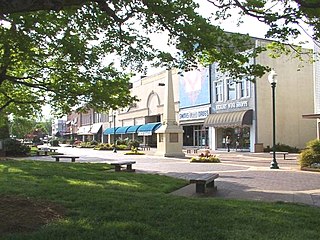
Hickory is a city in North Carolina primarily located in Catawba County. It is the 24th most populous city in North Carolina, with its formal boundaries extending into Burke and Caldwell counties. It is located approximately 60 miles (97 km) northwest of Charlotte. Hickory's population in the 2020 census was 43,490. Hickory is the main city of the Hickory–Lenoir–Morganton Metropolitan Statistical Area, which had a population of 365,276 in the 2020 census.

Charles M. Goodman was an American architect who made a name for his modern designs in suburban Washington, D.C. after World War II. While his work has a regional feel, he ignored the colonial revival look so popular in Virginia. Goodman was quoted in the 1968 survey book Architecture in Virginia as saying that he aimed to "get away from straight historical reproduction."

Oakwood Historic District is a national historic district located at Hickory, Catawba County, North Carolina. It includes work designed by architects Wheeler & Stearn. It encompasses 50 contributing buildings, 1 contributing site, and 1 contributing structure in an upscale residential section of Hickory. It includes notable examples of Colonial Revival, Bungalow / American Craftsman, and Queen Anne style architecture dating from the 1880s to 1930s. Notable buildings include the Robert E. Simpson House (1922), Walker Lyerly House (1913), Cline-Wilfong House (1912), Abel A. Shuford, II House, Paul A. Setzer House (1927), John H. P. Cilley House (1912), (first) Charles H. Geitner House (1900), Benjamin F. Seagle House, David L. Russell House, Robert W. Stevenson House, Jones W. Shuford House (1907), Dr. Robert T. Hambrick House (1928), Alfred P. Whitener House, and J. Summie Propst House (1881-1883).
Richard Sharp Smith was an English-born American architect, associated with Biltmore Estate and Asheville, North Carolina. Clay Griffith with the North Carolina State Historic Preservation Office says, "The influence of Richard Sharp Smith’s architecture in Asheville and western North Carolina during the first quarter of the twentieth century cannot be overstated." His vernacular style combines elements of Craftsman, Colonial Revival, English cottage, Shingle, and Tudor Revival architectural styles. He is associated with some of America's important architectural firms of the late 19th century—Richard Morris Hunt, Bradford Lee Gilbert, and Reid & Reid.
Charles Christian Hook (1870–1938) was an American architect. He was also the founder of FreemanWhite, Inc. a Haskell Company (1892), the oldest practicing firm in North Carolina and currently the 11th oldest architecture firm in the United States.
Downtown Asheville Historic District is a national historic district located at Asheville, Buncombe County, North Carolina. The district encompasses about 279 contributing buildings and one contributing object in the central business district of Asheville. It includes commercial, institutional, and residential buildings in a variety of popular architectural styles including Colonial Revival, Queen Anne, and Art Deco.

Lenoir Downtown Historic District is a national historic district located at Lenoir, Caldwell County, North Carolina. The district includes 41 contributing buildings and 2 contributing objects in the central business district of Lenoir. It includes commercial, governmental, and institutional buildings in a variety of popular architectural styles including Art Deco, Art Moderne, Classical Revival and Tudor Revival. Notable contributing resources include the Center Theater (1941), O. P. Lutz Furniture Company and Lutz Hosiery Mill (1939), Dayvault's Drug Store (1937), Caldwell County Agricultural Building (1937), Courtney Warehouse, Masonic Hall, Miller Building, Confederate Monument (1910), Belk's Department Store (1928), Lenoir Building (1907), J. C. Penney Department Store, Fidelity Building (1928), and U. S. Post Office (1931). Located in the district is the separately listed Caldwell County Courthouse.

The Lyerly Full Fashioned Mill is a historic hosiery mill located in Hickory, Catawba County, North Carolina. It was built in two stages between 1930 and 1934, and is a two-story, rectangular, nine-by-twelve bay brick building. It features a Moderne-Style 2 1/2-story stair tower. The mill remained in operation until 1957, after which the building was used as a warehouse for a number of years.

Kenworth Historic District is a national historic district located at Hickory, Catawba County, North Carolina. The district encompasses 52 contributing buildings and 2 contributing structures in the planned subdivision of Kenworth in Hickory. Most of the buildings date between the early- and mid-20th century and include notable examples of Colonial Revival and Bungalow / American Craftsman style architecture. Notable buildings include the (former) Christ Lutheran Church (1926), Kenworth Elementary School (1913), Frederick O. Bock House (1923), Nichelson-Abernethy House (1922), Speas-Duval House (1921), Clyde L. Herman House, Kennedy-Setzer House (1921), and Payne-Bothwell-Scheller House (1921).

Claremont High School Historic District is a national historic district located at Hickory, Catawba County, North Carolina. The district encompasses 172 contributing buildings and 3 contributing structures in a predominantly residential section of Hickory. Most of the dwellings date from the late 19th through mid-20th century and include notable examples of Queen Anne, Colonial Revival, Tudor Revival, and Bungalow / American Craftsman style architecture. The Claremont High School was completed in 1925, and is a three-story, "H"-shaped, Neoclassical style school. The school was rehabilitated in 1986 as an arts and science center. Other notable buildings include Maple Grove, Shuler-Harper House (1887), Harvey E. McComb House (1889), (former) Corinth Reformed Church Parsonage (1895), Shuford L. Whitener House, Judge W. B. Councill House (1902), George W. Hall House, Carolina Park, Josephine Lyerly House, John L. Riddle House (1918), Marshall R. Wagner House (1938), David M. McComb Jr. House (1939), Arthur H. Burgess House (1940), and R. L. Noblin House (1950).

Thomasville Downtown Historic District is a national historic district located at Thomasville, Davidson County, North Carolina. The district encompasses 46 contributing buildings, 1 contributing site, 2 contributing structures, and 2 contributing objects in the central business district of Thomasville. It includes commercial and governmental buildings built between 1871 and 1938. Located in the district is the separately listed Thomasville Railroad Passenger Depot. Other notable contributing resources include The Big Chair (1950), the former City Hall (1938), the former Davidson County Office Building, the former United States Post Office (1926), (former) Davidson County Office Building (1957), the Dr. Orien R. Hodgin Dental Office, the North State Telephone Warehouse, First National Bank of Thomasville (1922), C. R. Thomas Block, and the Lambeth Furniture Company/Thomasville Chair Company.

Downtown Mocksville Historic District is a national historic district located at Mocksville, Davie County, North Carolina. The district encompasses 21 contributing buildings and 1 contributing object in the central business district of Mocksville. It primarily includes residential and commercial buildings with notable examples of Classical Revival and Beaux-Arts style architecture. The district includes the previously listed Davie County Courthouse. Other notable buildings include the Davie County Jail (1916), (former) C. C. Sanford Sons Store (1937), (former) J. T. Baity/Anderson Store, (former) Meroney Hardware Company Building (1922-1924), Sanford Brothers Building (1927), (former) Southern Bank &. Trust Company Building (1923), (former) Princess Theatre, J. T. Angell Building (1910), Horn Service Station, (former) Kurfees and Ward Pure Oil Station, (former) Meroney Filling Station, and Johnstone Office Building (1939).

Downtown Gastonia Historic District is a national historic district located at Gastonia, Gaston County, North Carolina. It encompasses 77 contributing buildings and 1 contributing object in the central business district of Gastonia. The commercial, civic, institutional, and multi-unit residential buildings were built between the 1890s and 1954, and include notable examples of Colonial Revival and Classical Revival architecture. Located in the district are the separately listed former Gaston County Courthouse, First National Bank Building, Third National Bank Building, and Robinson-Gardner Building. Other notable buildings include the U.S. Post Office (1935), York Medical Building (1938), Kress Department Store, Leibowitz Department Store, Ideal Moving Picture Theater, City Hall, Kirby Building (1922), First Baptist Church (1922), Gaston County War Memorial Hall (1928), and the (former) Gaston County Public Library (1930).

Downtown Greensboro Historic District is a national historic district located at Greensboro, Guilford County, North Carolina. When first listed, the district encompassed 96 contributing buildings in the central business district of Greensboro. The commercial buildings were built between about 1885 and the 1930s in a variety of popular architectural styles including Italianate and Art Deco. Located in the district is the separately listed Jefferson Standard Building. Other notable buildings include the Vanstory Building, Kress Building (1929), Woolworth's, Efrid's Department Store, Montgomery Ward (1936), the Carolina Theatre (1927), Center Theatre (1948), the former Belk Building (1939), Ellis Stone/Thalhimer's Department Store (1949-1950), and the former American Exchange National Bank Building (1920). The Woolworth's store is notable as the site of the Greensboro sit-ins of 1960.

Brooklyn Historic District is a national historic district located at Smithfield, Johnston County, North Carolina. It encompasses 88 contributing buildings in a predominantly residential section of Smithfield. It includes notable examples of Queen Anne style architecture and buildings dating from about the 1870s through the 1940s. Located in the district is the separately listed Hood-Strickland House. Other notable buildings include the Smithfield Elementary School (1912-1913), the Smithfield Steam Laundry, Woodall-Fleming House, Davis-Boyette House (1889), Ellington-Holland House, Willis Henry Austin House (1912), Dr. Thel Hooks House (1916), and Ragsdale-McLemore House (1922).
Downtown Selma Historic District is a national historic district located at Selma, Johnston County, North Carolina. It encompasses 59 contributing buildings and 1 contributing structure in the central business district of Selma. It includes notable examples of Classical Revival, Colonial Revival, Art Moderne, Art Deco, and Gothic Revival style architecture and buildings dating from about 1875 to 1960. Notable buildings include the Bank of Selma/American Telephone and Telegraph Exchange Building, Economy Furniture, John A. Mitchener Building (1925), The Rudy Theater, The Hardware Store, Bank of Selma, Selma Baptist Church, and Selma Manufacturing Company/Selma Furniture Store and Opera House (1902).
Masonboro Sound Historic District is a national historic district located near Wilmington, New Hanover County, North Carolina. The district encompasses 22 contributing buildings, 2 contributing sites, 8 contributing structures, and 1 contributing object near Wilmington. The district developed during the 19th and early-20th century and includes notable examples of Italian Renaissance and Colonial Revival style architecture. There are 10 contributing dwellings and 13 contributing outbuildings. Notable dwellings include the Carr-Ormand House (1932), Willard-Sprunt-Woolvin House (1880), Cazaux-Williams-Crow House, Parsley-Love House, Live Oaks (1913), Taylor-Bissinger House (1937), the "Doll House" (1924), and Hill-Anderson Cottage.
Willard Close Northup (1882–1942) was an American architect in North Carolina who was the principal partner in the firm Northup & O'Brien. His firm was based in Winston-Salem, North Carolina. Northup began his architectural practice in 1906 and partnered with Leet Alexander O'Brien (1891–1963) in 1915 or 1916. Luther Lashmit joined the firm in 1927, and was lead architect for Graylyn while an employee of the firm.

Downtown Albemarle Historic District is a national historic district located at Albemarle, Stanly County, North Carolina. The district encompasses 20 contributing buildings in the central business district of Albemarle. They were built between about 1898 and 1950 and include notable examples of Early Commercial architecture. Located in the district and separately listed is the Starnes Opera House. Other notable buildings include the Central Lunch, Farmers Hardware and General Store (1898), King Block I (1898), King Block II (1898), King Block III (1898), J. C. Parker Building (1898), King Building (1898), Hall's Pharmacy Building, Efird Dry Goods Store (1903), The Enterprise Steam Print Building (1922), "The Big Store" (1898), Fitzgerald Building (1927), and Morgan Furniture Building (1924).
Downtown Garner Historic District, also known as Garner's Station, is a national historic district located at Garner, Wake County, North Carolina. The district encompasses 62 contributing buildings and 1 contributing site in the central business district and surrounding residential sections of Garner. The district developed between about 1883 and 1940 and includes notable examples of Queen Anne, Classical Revival, and Bungalow / American Craftsman style architecture. Notable buildings include the Garner Depot, (former) Garner High School (1923), Hayes Chapel Christian Church, H. D. Rand Store, Bank of Garner Building, Section Foreman's Bouse, Joe Broughton Bouse, J. J. Bagwell House, W. L. Brooks House, and D. B. Buffaloe House (1923).

















